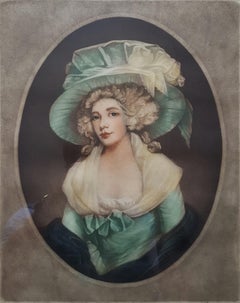Lynd Ward, 'Judges' from the series 'Moriae Encomium (In Praise of Folly),' mezzotint, 1943, no edition, proofs only. Signed, dated, and titled in pencil. A superb, richly-inked impression, on cream wove paper; the full sheet with margins (1 1/4 to 2 inches) in excellent condition. Scarce. Matted to museum standards, unframed.
Image size 7 13/16 x 4 7/8 inches (198 x 124 mm); sheet size 10 3/4 x 8 1/8 inches (273 x 206 mm).
Created by the artist for 'Erasmus's Moriae Encomium,' or 'In Praise of Folly,' published by the Limited Editions Club, 1943. A rare, signed, proof impression apart from the Limited Editions Club publication.
ABOUT THE ARTIST
Lynd Ward is acknowledged as one of America’s foremost wood engravers and book illustrators of the first half of the twentieth century. His innovative use of narrative printmaking as a stand-alone storytelling vehicle was uniquely successful in reaching a broad audience. The powerful psychological intensity of his work, celebrated for its dynamic design, technical precision, and compelling dramatic content, finds resonance in the literature of Poe, Melville, and Hawthorne. Like these classic American writers, Ward was concerned with the themes of man’s inner struggles and the role of the subconscious in determining his destiny. An artist of social conscience during the Great Depression and World War II, he infused his graphic images with his unique brand of social realism, deftly portraying the problems that challenged the ideals of American society.
The son of a Methodist preacher, Lynd Ward, moved from Chicago to Massachusetts at an early age. He graduated from the Teachers College of Columbia University, New York, in 1926, where he studied illustration and graphic arts. He married May Yonge McNeer in 1936 and left for Europe for their honeymoon in Eastern Europe. After four months, they settled in Leipzig, where Ward studied at the National Academy of Graphic Arts and Bookmaking. Inspired by Belgian expressionist artist Frans Masereel's graphic novel ‘The Sun,’ and another graphic novel by the German artist Otto Nückel, ‘Destiny,’ he determined to create his own "wordless" novel. Upon his return to America, Ward completed his first book, ‘God's Man: A Novel in Woodcuts,’ published in 1929. ‘Gods’ Man’ was a great success for its author and publisher and was reprinted four times in 1930, including a British edition. This book and several which followed it, ‘Madman’s Drum,’ 1930, ‘Wild Pilgrimage,’ 1932, ‘Prelude to a Million Years,’ 1933, ‘Song Without Words,' 1936, ‘Vertigo,’ 1937; and ‘Last Unfinished Wordless Novel’ (created in the 1960s and published in 2001) were comprised solely of Ward's wood engravings. Ward designed each graphic image to occupy an entire page, the sequence of which conveys the story's narrative.
In 1937, Ward was named Director of the Graphic Arts Division of the Federal Art Project, a division of the Works Progress Administration (WPA). In the following years, Ward went on to illustrate more than one hundred books (some of which he wrote), including classics for the Limited Editions Club Goethe’s ‘Faust,’ Faulkner’s ‘A Green Bough,’ and Mary Shelley’s ‘Frankenstein,’ and several children’s books. He also produced single-subject wood engravings, paintings, and drawings. His print ‘Sanctuary,’ 1939, was shown at the 1939 New York World’s Fair, and ‘Clouded Over,’ 1948, received the 1948 Library of Congress Award and was included in ‘American Prize Prints of the 20th Century’ by Albert Reese. He received the National Academy of Design Print Award (1949), the New York Times Best Illustrated Award (1973), and the Regina Award (Catholic Library Association, 1975). ‘The Biggest Bear,’ a children’s book with illustrations by Ward, was the recipient of the esteemed 1952 Caldecott Medal of the American Library Association.
An Honorary Fellow of the Royal Society of Painter-Etchers and Engravers, Ward was a member and board member of the National Academy of Design and the Artists’ League of America. He served several terms as president of the Society of American Graphic Artists and was a member of the American Artists Congress and the Society of Illustrators. Ward exhibited at the American Artists Congress; the National Academy of Design; the John Herron Art Institute; and the Library of Congress. He had a one-person show at Associated American Artists, NY, on the publication of his monograph 'Storyteller Without Words,' 1974; AAA mounted a memorial exhibition in 1986. The May 1976 issue of 'Bibliognost,' a book collector’s publication, was dedicated to Ward. ‘Lynd Ward, His Bookplate Designs,’ an article by Dan Burne Jones, was published in the American Society of Bookplate Collectors and Designers Yearbook, 1981/82.
In 2001, sixteen years after his death, Rutgers University Libraries published ’Lynd Ward’s Last Unfinished Wordless Novel.’ The blocks were intended to be part of a novel in woodcuts, the first since Vertigo, but Ward did not live to complete the project. Master printer and book designer Barbara Henry collated and printed the twenty-six finished blocks out of the forty-four initially planned for the still unnamed narrative.
In 2010 the Library of America honored Ward’s achievements with the meticulous production of a collection of Ward’s woodcut novels—the first time the Library had gone wordless. The publication replicated his original editions with a single full-size image printed on the right page of each double-page spread. In his introduction to the books, renowned cartoonist/
illustrator Art...



